同济大学:《软件测试》课程电子教案(PPT课件)How To Do High Quality Research, Write Acceptable Papers, and Make Effective Presentations?

How To Do High Quality Research, Write Acceptable Papers,and Make Effective Presentations? Qinpei Zhao http://sse.tongji.edu.cn/zhaoqinpei/
How To Do High Quality Research, Write Acceptable Papers, and Make Effective Presentations? Qinpei Zhao http://sse.tongji.edu.cn/zhaoqinpei/

Outline General information on how to do research How to write a scientific paper? How to give a scientific presentation? Practice your research skills in software testing(1st SSE Conference on Software Testing)
Outline ◼ General information on how to do research ❑ How to write a scientific paper? ❑ How to give a scientific presentation? ◼ Practice your research skills in software testing(1 st SSE Conference on Software Testing)
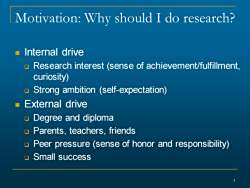
Motivation:Why should I do research? Internal drive Research interest (sense of achievement/fulfillment. curiosity) Strong ambition (self-expectation) External drive Degree and diploma Parents,teachers,friends Peer pressure (sense of honor and responsibility) ▣Small success
3 Motivation: Why should I do research? ◼ Internal drive ❑ Research interest (sense of achievement/fulfillment, curiosity) ❑ Strong ambition (self-expectation) ◼ External drive ❑ Degree and diploma ❑ Parents, teachers, friends ❑ Peer pressure (sense of honor and responsibility) ❑ Small success
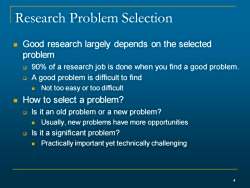
Research Problem Selection Good research largely depends on the selected problem 90%of a research job is done when you find a good problem. A good problem is difficult to find Not too easy or too difficult How to select a problem? Is it an old problem or a new problem? Usually,new problems have more opportunities Is it a significant problem? Practically important yet technically challenging
4 Research Problem Selection ◼ Good research largely depends on the selected problem ❑ 90% of a research job is done when you find a good problem. ❑ A good problem is difficult to find ◼ Not too easy or too difficult ◼ How to select a problem? ❑ Is it an old problem or a new problem? ◼ Usually, new problems have more opportunities ❑ Is it a significant problem? ◼ Practically important yet technically challenging
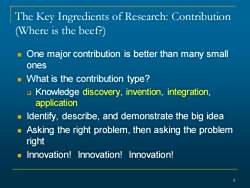
The Key Ingredients of Research:Contribution (Where is the beef? One major contribution is better than many small ones What is the contribution type? Knowledge discovery,invention,integration, application Identify,describe,and demonstrate the big idea Asking the right problem,then asking the problem right Innovation!Innovation!Innovation!
5 The Key Ingredients of Research: Contribution (Where is the beef?) ◼ One major contribution is better than many small ones ◼ What is the contribution type? ❑ Knowledge discovery, invention, integration, application ◼ Identify, describe, and demonstrate the big idea ◼ Asking the right problem, then asking the problem right ◼ Innovation! Innovation! Innovation!

Innovation!Innovation!Innovation! How to Find Research Problems? New solution to old problems (classical problems) ■ New problems New areas 6
6 Innovation! Innovation! Innovation! How to Find Research Problems? ◼ New solution to old problems (classical problems) ◼ New problems ◼ New areas

1.New Solution to Old Problems New solution to a reduced problem New solution from the same area New solution from other areas
7 1. New Solution to Old Problems ◼ New solution to a reduced problem ◼ New solution from the same area ◼ New solution from other areas
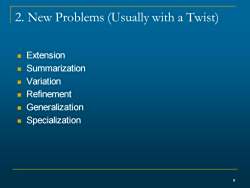
2.New Problems (Usually with a Twist) Extension Summarization Variation Refinement ■Generalization Specialization
8 2. New Problems (Usually with a Twist) ◼ Extension ◼ Summarization ◼ Variation ◼ Refinement ◼ Generalization ◼ Specialization
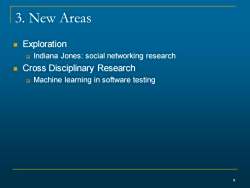
3.New Areas Exploration Indiana Jones:social networking research Cross Disciplinary Research Machine learning in software testing 9
9 3. New Areas ◼ Exploration ❑ Indiana Jones: social networking research ◼ Cross Disciplinary Research ❑ Machine learning in software testing
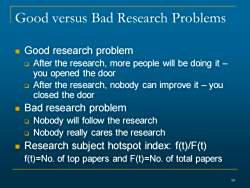
Good versus Bad Research Problems Good research problem After the research,more people will be doing it you opened the door After the research,nobody can improve it you closed the door ■Bad research problem Nobody will follow the research Nobody really cares the research Research subject hotspot index:f(t)/F(t) f(t)=No.of top papers and F(t)=No.of total papers 10
Good versus Bad Research Problems ◼ Good research problem ❑ After the research, more people will be doing it – you opened the door ❑ After the research, nobody can improve it – you closed the door ◼ Bad research problem ❑ Nobody will follow the research ❑ Nobody really cares the research ◼ Research subject hotspot index: f(t)/F(t) f(t)=No. of top papers and F(t)=No. of total papers 10
按次数下载不扣除下载券;
注册用户24小时内重复下载只扣除一次;
顺序:VIP每日次数-->可用次数-->下载券;
- 同济大学:《软件测试》课程电子教案(PPT课件)Chapter 06 Tool Support for Testing.pptx
- 同济大学:《软件测试》课程电子教案(PPT课件)Chapter 05 Test Management.pptx
- 同济大学:《软件测试》课程电子教案(PPT课件)Chapter 04 Test Design Techniques.pptx
- 同济大学:《软件测试》课程电子教案(PPT课件)Chapter 03 Static Techniques.pptx
- 同济大学:《软件测试》课程电子教案(PPT课件)Chapter 02 Testing throughout the Software Lifecycle.pptx
- 同济大学:《软件测试》课程电子教案(PPT课件)Chapter 01 Soft Testing - Fundamentals of Testing.pptx
- 西安电子科技大学:《网络计算》课程PPT教学课件(Android Programming)Lecture 10 Multimedia.pptx
- 西安电子科技大学:《网络计算》课程PPT教学课件(Android Programming)Lecture 9 Service and Broadcast Receiver.pptx
- 西安电子科技大学:《网络计算》课程PPT教学课件(Android Programming)Lecture 8 Multi-threading.pptx
- 西安电子科技大学:《网络计算》课程PPT教学课件(Android Programming)Lecture 7 Data Persistence.pptx
- 西安电子科技大学:《网络计算》课程PPT教学课件(Android Programming)Lecture 6 List View and Custom View.pptx
- 西安电子科技大学:《网络计算》课程PPT教学课件(Android Programming)Lecture 5 Intent.pptx
- 西安电子科技大学:《网络计算》课程PPT教学课件(Android Programming)Lecture 4 Activity, Intent and UI.pptx
- 西安电子科技大学:《网络计算》课程PPT教学课件(Android Programming)Lecture 3 File structure and Layout.pptx
- 西安电子科技大学:《网络计算》课程PPT教学课件(Android Programming)Lecture 2 Introduction to Java and Object Oriented Programming.pptx
- 西安电子科技大学:《网络计算》课程PPT教学课件(Android Programming)Lecture 1 Introduction to Network Computing(主讲:栾浩).pptx
- 《算法基础》课程教学资源(学习笔记)算法基础 课堂笔记.pdf
- 长沙理工大学:《微机原理与接口技术》课程教学资源(大纲教案)微机原理与应用授课教案(负责人:叶青,打印版).pdf
- 同济大学:《逻辑网络》课程电子教案(PPT课件)数字设计中的基本电路 Introduction to the circuits in digital design.ppt
- 同济大学:《逻辑网络》课程电子教案(PPT课件)异步时序电路分析与设计 Introduction to asynchronous circuits design.ppt
- 《软件测试》课程电子教案(参考资料)Standard glossary of terms used in Software Testing(Version 2.0).pdf
- 《软件测试》课程电子教案(参考资料)Certified Tester Foundation Level Syllabus Released(Version 2011).pdf
- 《软件测试》课程电子教案(参考资料)Certified Tester Foundation Level Syllabus Released(Version 2011).pdf
- 河南科技大学:信息工程学院教育技术学专业本科课程教学大纲(汇编).pdf
- 吉林大学:《人工智能》课程电子教案(PPT课件)第一章 绪论 Artificial Intelligence(AI).ppt
- 吉林大学:《人工智能》课程电子教案(PPT课件)第七章 机器学习.ppt
- 吉林大学:《人工智能》课程电子教案(PPT课件)第三章 知识与知识表示.ppt
- 吉林大学:《人工智能》课程电子教案(PPT课件)第二章 人工智能的数学基础.ppt
- 吉林大学:《人工智能》课程电子教案(PPT课件)第五章 搜索策略.ppt
- 吉林大学:《人工智能》课程电子教案(PPT课件)第八章 智能决策支持系统.ppt
- 吉林大学:《人工智能》课程电子教案(PPT课件)第六章 专家系统.ppt
- 吉林大学:《人工智能》课程电子教案(PPT课件)第四章 经典逻辑推理.ppt
- 吉林大学:《微机原理及汇编语言》课程电子教案(PPT课件)第10章 80X86的最新技术发展.ppt
- 吉林大学:《微机原理及汇编语言》课程电子教案(PPT课件)第1章 绪论(主讲人:赵宏伟).ppt
- 吉林大学:《微机原理及汇编语言》课程电子教案(PPT课件)第2章 8088指令系统.ppt
- 吉林大学:《微机原理及汇编语言》课程电子教案(PPT课件)第3章 汇编语言程序设计.ppt
- 吉林大学:《微机原理及汇编语言》课程电子教案(PPT课件)第4章 8088的总线操作和时序.ppt
- 吉林大学:《微机原理及汇编语言》课程电子教案(PPT课件)第5章 半导体存储器.ppt
- 吉林大学:《微机原理及汇编语言》课程电子教案(PPT课件)第6章 输入和输出.ppt
- 吉林大学:《微机原理及汇编语言》课程电子教案(PPT课件)第7章 中断.ppt
